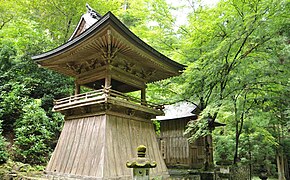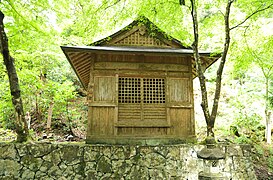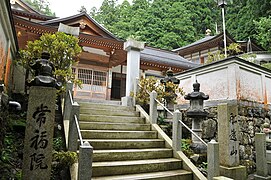Ruri-ji (Hyōgo)
The Ruri-ji ( Japanese 瑠 璃 寺 ) with the mountain name Funakoshi-san ( 船 越 山 ) is a temple of the Kōyasan branch ( 高 野山 真言 宗 Kōyasan-shingon-shū ) of the Shingon direction of Buddhism in Sayō, Sayō County ( 佐 用 郡 佐 用町 ) in Hyogo prefecture . It is located on the eastern slope of the Funakoshi Mountain and is the 33rd and, according to the traditional count, the last temple on the New Saigoku Pilgrimage .
history
According to tradition, priest Gyōki went ashore in the port of Morozu ( 室 津 ) in 728 and saw a shining square in the north. When Gyōki had reached the foot of the mountains to take a closer look, he met an old man who said, "I am the teaching holy doctor of the Jōruri world ( 浄 瑠 璃 世界 )" and turned into a shining golden Buddha. Gyōki then asked Emperor Shōmu to help him build a temple, which he did. The emperor is commemorated in the Shōten Hall, whose name is a contraction of the imperial name Shōmu Tennō.
In modern times the Ruri-ji belonged to the Shōgo-in ( 聖 護 院 ) in Kyōto and flourished as a place of the Shugendō and was also called Nankō-bo ( 南 光 坊 ). There were many Yamabushi and Shugen devotees in this area who were looked after by the temple. During the time of the north and south courts and the Muromachi period , there were close ties to the "men of Harima" ( 播 磨 の 雄 Harima no o ) and the Akamatsu clan , the old temples were politically active.
investment
Down in the valley, the temple gate ( 山門 Sammon ) welcomes the pilgrim, which is designed here as a Niō gate ( 仁王 門 ), i.e. as a gate with the two temple slaughterers to the right and left of the passage. From there it is another 800 m in a side valley to the northeast to the temple area. You cross a stream and climb up to the temple and then you have the main hall ( 本 堂 Hondō ; 1 in the plan) in front of you. Next to it stands the temple bell ( 鐘楼 Shōrō ; 2) on a pedestal and the small Kaisan hall ( 開山 堂 ; 3), which is dedicated to the temple founder. Further buildings of the temple follow to the right, the Goma Hall ( 護 摩 堂 ; 4) and the Shōten Hall ( 聖 天堂 ; 5).
To the left of the main hall is the abbot and monk's quarters (A). Below, on the other side of the stream, there is a sub-temple, the Jōfuku-in ( 常 福 院 ; J).
Temple treasures
The following treasures are registered as important cultural assets of Japan :
- A holy Fudō Myōō with two child companions, colored on silk ( 絹本 著色 不 動 明王 二 童子 像 Kenpon chakuchoku Fudō Myōō nidōji zō ), kept in the Nara National Museum . The group shows characteristics of the late Heian period , but dates from the beginning of the Kamakura period . At the bottom left you can see the companion Kongara ( 矜 羯 羅 ), on the right the seitaka ( 制 叱 迦 ). Fudō sits in the middle on a stone.
- A seated Fudō Myōō made of wood ( 木造 不 動 明王 坐像 Mokuzō Fudō Myōō zazō ), Heian period. It is located in the Goma Hall.
photos
literature
- Hyōgo-ken no rekishi sampo henshu iinkai (ed.): Ruri-ji . In: Hyogo-ken no rekishi sampo (ge). Yamakawa Shuppan, 2012. ISBN 978-4-634-24828-1 . Pp. 151 to 152.
Web links
Coordinates: 35 ° 6 ′ 12.3 " N , 134 ° 25 ′ 25.6" E








